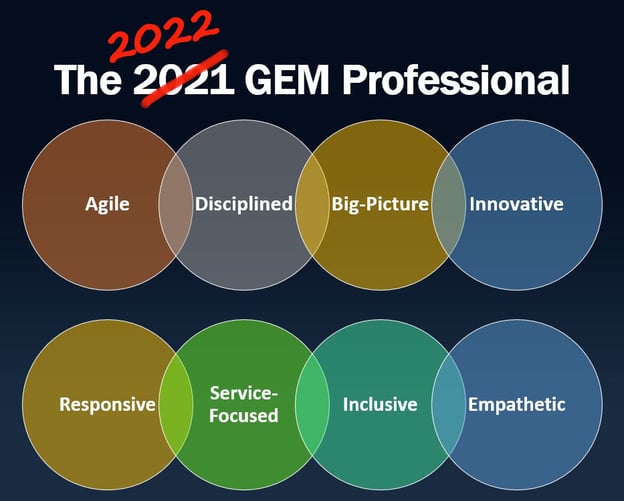I had the privilege of serving as the keynote speaker in the fall of 2020 for the NEGAP/NYGAP Virtual Regional Summit.
When I was asked to speak, it seemed the obvious topic of the day was to discuss the impacts of COVID-19 on graduate enrollment management, but I wasn't convinced a book report on what everyone already knew was going to be all that impactful. And frankly I didn't think merely being resilient at the time was enough, for ourselves or our work.
The reality is that our world has been full of uncertainty the past two years for obvious reasons, and much of this leaves us with more questions than answers about the future of higher education, let alone graduate enrollment. Couple that with the financial, political, and social challenges that complicate our lives both inside and outside the workplace, and it’s all a rather complex puzzle.
It was abundantly clear at the time – and still today – that we all had to approach our lives and our work with some level of grace as we dealt with these, dare I say, unprecedented times. And we had to do that as our campuses grappled with a variety of COVID-related financial challenges, asking us to do more with less and to help our institutional communities collectively weather what the pandemic brought on. Our now “post” pandemic life has a new set of challenges, but our need for resilience remains the same.
Read on for what I believe graduate enrollment professionals need to do to thrive now in 2022 and beyond.
The Backdrop
We know that COVID-19 created a number of major issues: a struggling "Main Street" economy; high unemployment; direct financial impacts to our institutions, individuals, and governments; and threats to our health and safety.
Now two years later, we have a robust job market (which may not be long-lived), soaring inflation, and economic and geopolitical challenges that could plunge the U.S. and beyond into recession. All of these issues contribute to an already complicated graduate enrollment picture:
- Declining high school graduates across the nation culminating in the eminent "cliff" expected after 2025
- Resource strain on graduate enrollment offices (human, financial, and even technological)
- Social justice impacts on equity and access to higher education
- Diverse opinions on the value of a graduate education
- Growing pressures on alternative revenue sources for campuses heavily reliant on undergraduate revenue.
Our collective survival in graduate enrollment means not only getting through the short-term challenges presented by the pandemic and the new problems of the day, but also continuing to adapt to the rapidly changing needs of our campuses and higher education as a whole.
By now, you're probably aware that data from the National Student Clearinghouse shows master's degree enrollments up 2.3 percent in the U.S. in fall 2021 and doctoral enrollments up 2.0 percent, but growth slowed from fall 2020 (up 3.4% and 2.8%, respectively). Bachelor’s degree enrollment fell for the second consecutive year.
While graduate enrollments remain up across all non-profit institutions, for-profit institutions experienced declines of 9.5 percent in graduate enrollments in fall 2021.
Opportunities
Though our minds, virtual conversations, and news cycles have been dominated by bad news, we've found some silver linings that relate directly to our work in graduate enrollment:
1. Employers generally want more employees with a graduate education
The demand for graduate education hasn't gone away, which generally holds true across most industries.
2. Our schools will be looking at graduate education differently
Many institutions rely heavily on undergraduate education as the primary source of revenue sustainability and growth. As undergraduate enrollments are strained by demographic shifts and impacted by the direct effects of the pandemic, schools will need to more deliberately diversify for long-term survival.
3. Virtual events are here to stay and they greater access for prospective students
Even before the pandemic, many graduate school-going students couldn't afford to travel to visit their prospective graduate schools. Our collective pivot to more virtual events provides students with limited means an opportunity to connect more deeply with our institutions and programs earlier in the enrollment funnel.

The 2022 GEM Professional
In my presentation at the time, I identified eight core descriptors for the graduate enrollment professional. Now more than ever, these key characteristics still ring true:
1. Agile
I'd argue that you'd never survive work as a graduate enrollment professional if you couldn't pivot on a dime. That pivot in March 2020 moved our work largely remote, forced recruitment events almost completely online, and created a blurred work schedule with seemingly few boundaries.
If we learned anything, rising to meet the past two years’ challenges required flexibility and a lot of perspective. These realities will continue for the foreseeable future. We'll continue to be asked to do more with less and in many cases, graduate enrollments (and the people responsible for them) will have a much larger supporting role on our campuses.
Keys to Success
- Stay flexible
- Stay positive
- Be prepared for what I call "informed pivots." Arm yourself with prospective and current student data and industry trends so that when you have to adjust, you're prepared to shift quickly and successfully.
2. Disciplined
The challenge of the day is finding how we can personally and professionally stay productive so that we can provide some stability on our campuses and at home, all while trying to maintain our own sanity.
We are all struggling with our own emotional and mental well-being, wondering if we're doing or being enough at all hours of the day. I'm giving you permission to give yourself some grace - this has been a hard time for everyone and we're all working through it differently.
That said, though time is a precious commodity, one of the best things we can all do as GEM professionals is to continue to dedicate time to personal and professional growth. That allows us to feel some control over our destiny and to feel empowered to handle what's coming down the pike.
Keys to Success
- Ask for help where you need it
- Create a routine
- Adapt a growth mindset
- Seek out opportunities to learn
- Take time to assess your path.
3. Big-Picture
We're all in this work because we want to help students. The unfortunate reality is that at the end of the day, our institutions have to operate as a business so that we can continue offering a high-quality educational experience.
It's easy in challenging times to get bogged down in the "need more students" directive.
We can't get stuck there.
Particularly in admissions, we often feel pressure for increasing enrollments, and that increases as our institutions feel a greater pinch in hard times. I had a colleague a number of years ago who after hearing about some numbers pressure said, "This isn't why I got into this work." The truth is, none of us did.
We have to remember that admissions is a cog in the bigger wheel of providing a quality education that will help students grow and achieve their personal and professional dreams. We are a part of that. By increasing enrollments and helping sustain our institutions, we're providing a means for us to continue helping students achieve those dreams for many years to come.
That big picture and our presumably larger part in that over the coming years has to be central to our work. We'll foster that work through strategic planning across the graduate enrollment lifecycle.
Keys to Success
- Conduct a SWOT analysis of each of your practices, programs and resources
- Create a retention plan (assess current circumstances, plan, execute, and repeat)
- Have ideas for how graduate enrollment can fit more deeply into your campus culture as our leaders come knocking.
4. Innovative
As we all were forced abruptly online in 2020, we had to think quickly how we would be able to market our programs and recruit in a fully virtual environment.
The problem?
Every institution was doing the same thing.
Some schools were certainly more prepared than others. The now very crowded digital marketing space forces all of us, particularly those of us at lesser known schools, to get creative. GEM professionals can't simply keep on the status quo - we have to innovate and be entrepreneurial in our work.
That innovation can come in a variety of forms:
- Content and content delivery
- Operational efficiencies
- Recruitment tactics
- Service improvements
- New programs
- And more
Keys to Success
- Think well beyond the box (even if your institution doesn't initially embrace it)
- Audit your entire operations, marketing, and support structures
- Make sure the right people are aligned to the right roles. Now may be a time to embrace unique talents on your teams, even if it goes beyond traditional job descriptions.
5. Responsive
When I say responsive, I'm largely focused on market responsive.
One thing I can criticize most of us on in graduate enrollment is that there is a dearth of helpful content for prospective students. Sure, we have our catalog copy and perhaps a tombstone-like presence on our websites for each of our programs. But what about actual content?
We should be creating:
- Articles about applying to graduate school
- Blog posts about successfully navigating financial aid
- Podcasts about finding a job in XYZ discipline
- Videos with faculty discussing their research
Broadly, we haven’t done enough of it. And for first-generation students, who are a growing number for graduate schools, these resources are particularly necessary.
If we think about even our own consumption of content online, are we more prone to click on a sales pitch or something that drives value for us? That's never been more important than a world that moved almost entirely online and remains there today.
People want value and they want resources. They need institutions and specifically GEM professionals to be helpful. And with all of the technology we have available to us, they want content that is personalized to them (I can't express enough my frustration when I see emails that begin with, "Dear student...")
What's even more concerning to me is a recent stat from the 2020 Marketing and Recruitment Practices for Graduate Students report from Ruffalo Noel Levitz and NAGAP: approximately 70 percent of public and private institutions responded in a research survey that undergraduate enrollment departments were responsible for generating their graduate inquiries.
How are we still talking about antiquated marketing and enrollment structures for graduate recruitment? Maybe the pandemic and the multitude of enrollment challenges to come will force institutions to take a critical look at how to leverage specialized knowledge about graduate populations and their needs and better align resources for graduate enrollment.
Keys to Success
- Assess where your students are and adjust your channels appropriately
- Identify program-specific personas to inform your marketing strategy
- Utilize predictive models for efficiencies
- Consider using inbound marketing strategies with "altruistic" content to provide alternatives to your competition.
6. Service-Focused
In addition to providing content that is specific to each student's needs, we must think about how we are providing that content.
Are we providing information quickly? Are we taking a few extra minutes to write a more thorough and helpful response to an email? Are we becoming a trusted asset to the student during their graduate school journey?
As everyone struggled through these challenging times, I'd argue that brands who provided a little bit of grace to prospective and current students fared better than others. While we as GEM professionals may not be the source of students' stress, we have the opportunity to alleviate some of that stress, particularly for students who are navigating graduate school for the first time.
I received a handwritten note from a student recently that not only thanked me for my help, but also for my kindness and sense of humor during her application process. We never know what students may be dealing with outside of school; we need to make our interactions more personal and supportive, even if it takes a bit more time. Sadly, a positive customer service experience can still be a market differentiator.
Keys to Success
- Audit your communication plan
- Adapt your RFI response model to support your prospective students' needs
- Consider allowing yourself and other staff some more time with each student as we navigate this new normal.
7. Inclusive
Our national landscape has been dominated by a variety of issues the past two years, but among the most important are those around racial and social justice.
As I shared during my keynote, these issues can be challenging to discuss because in an effort to talk about inclusion, we often try to be inclusive about who we are discussing to try to avoid upsetting anyone. Consider the Black Lives Matter movement and the echoes of "all lives matter" and other related retorts: by saying Black lives matter, there's a tendency for some to think the statement implies that others don't.
Of course all lives matter and all differences matter; Diversity, Equity, and Inclusion (DEI) work involves supporting a multitude of cultural, sexual, and other differences beyond just race. The reality is that right now, the racial divide in our country is among our most pressing issues and requires our attention.
We must address the racial divide and it starts with the white majority.
We must actively commit to anti-racism, a practice by which we choose to work to break down systems that inherently create inequities to people of color. It isn't enough to merely say, "I'm not a racist” - In fact, the statement is largely inaccurate for most of us that acknowledge the realities of the work we all need to do. We must all actively play a role in taking action that creates a more just system (even on our own campuses), particularly for Black Americans.
What made this all worse during the pandemic was according to the CDC, non-white groups were hospitalized due to COVID-19 four times as much as white people. Finally, National Student Clearinghouse data indicated that our largest growth in graduate enrollments again in 2020 was from non-whites: Asian +7%, Black +8.9%, Hispanic +13.3%, and Native American +7.3%, compared to +3.9% for White people. Our Black, Indigenous, and People of Color need more support and understanding as we navigate the challenges ahead.
Keys to Success
- Engage in anti-racist training or even read about it
- Assess all of your practices to ensure equity and justice for prospective and current students of color
- Create content that helps decipher various aspects of the graduate school process
- Consider adding anti-racist education for your students in orientation or other venues. Some important examples at Temple University and UC-Santa Barbara shows anti-racist education is beginning to gain some much-needed attention.
8. Empathetic
I left empathy deliberately at the end to have us all briefly pause for a moment.
We've endured an incredibly difficult couple of years personally and professionally: some have lost loved ones, some have battled COVID-19, and others have juggled the mental and physical strain of work, personal, and family commitments, all while trying to maintain our well-being in all senses of the term.
It is critical that we have an eye toward self-care and provide support to our family, friends, and colleagues throughout this time and beyond. For supervisors, this also means understanding the struggles of your employees (yes, even as you grapple with all of your own). And in that lens, I joked in my keynote that even though supervisors may appear to have their "stuff" together, we're all human, too, and the empathy goes both ways.
As we take a moment to understand all of the implications in our immediate circles, it is important to then realize that our prospective students have the same challenges as we're asking them to apply to graduate school or to attend classes. From concerns of financial stability and personal safety to emotional strain and chasing the perpetual to-do list, everyone is feeling it.
An August 2020 report from the Kaiser Family Foundation showed anxiety and depressive disorders among adults grew significantly from May to July: 40 percent of those surveyed experienced some anxiety or depressive disorder at least half of the days in July alone, up from 34.5 percent in May.
Keys to Success
- Consider third-party help (read: therapy)
- Seek out training for you and your staff to support students with emotional and mental health challenges
- Establish reasonable expectations for you and your employees
- Create opportunities to engage with your staff and employees for professional development or fun, "non-shop" activities. We need it.
Moving Forward
I waited all the way until the end to give you a very succinct list of what you should do as a graduate enrollment management professional as we continue to navigate challenging times:
- Be flexible.
- Embrace a growth mindset.
- Think about the full picture.
- Get creative.
- Adapt your marketing.
- Focus on service.
- Actively fight for equity.
- Build a culture of care and understanding for everyone.
We're a resilient community and I'm confident in not only our ability to survive the challenges of the day, but also to embrace the challenges and emerge stronger and more fruitful in our work in graduate enrollment management.

About Marcus Hanscom
Marcus Hanscom joined DD Agency in 2023 as Director of Enrollment Marketing after working more than 17 years in graduate and undergraduate enrollment management roles for private universities in New England. Since joining NAGAP in 2007, he has served in a variety of capacities on the NAGAP Board and on committees. He was awarded the NAGAP Distinguished Service Award in 2023 and is a co-host of the official NAGAP podcast, The NAGAP Report, and NAGAP's monthly leadership edition of The Exchange Live webinar series. He was the founding president of NEGAP, the New England Association for Graduate Enrollment Management.



